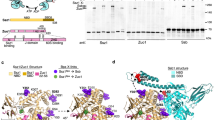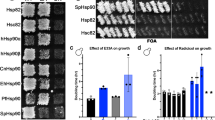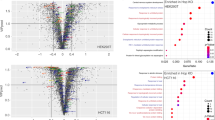Abstract
J-proteins are obligate partners of Hsp70s, forming a ubiquitous class of molecular chaperone machinery. The ribosome-associated Hsp70 of yeast Ssb binds nascent polypeptides as they exit the ribosome. Here we report that the ribosome-associated J-protein Zuo1 is the partner of Ssb. However, Zuo1 efficiently stimulates the ATPase activity of Ssb only when in complex with another Hsp70, Ssz1. Ssz1 binds ATP, but none of the 11 different amino acid substitutions in the ATP-binding cleft affected Ssz1 function in vivo, suggesting that neither nucleotide binding nor hydrolysis is required. We propose that Ssz1's predominant function in the cell is to facilitate Zuo1's ability to function as a J-protein partner of Ssb on the ribosome, serving as an example of an Hsp70 family member that has evolved to carry out functions distinct from that of a chaperone.
This is a preview of subscription content, access via your institution
Access options
Subscribe to this journal
Receive 12 print issues and online access
$189.00 per year
only $15.75 per issue
Buy this article
- Purchase on Springer Link
- Instant access to full article PDF
Prices may be subject to local taxes which are calculated during checkout







Similar content being viewed by others
References
Hartl, F. & Hayer-Hartl, M. Molecular chaperones in the cytosol: from nascent chain to folded protein. Science 295, 1852–1858 (2002).
Bukau, B., Deuerling, E., Pfund, C. & Craig, E.A. Getting newly synthesized proteins into shape. Cell 101, 119–122 (2000).
Bukau, B. & Horwich, A.L. The Hsp70 and Hsp60 chaperone machines. Cell 92, 351–366 (1998).
Kelley, W. Molecular chaperones: How J domains turn on Hsp70s. Curr. Biol. 9, R305–R308 (1999).
Kelley, W.L. The J-domain family and the recruitment of chaperone power. Trends Biochem. Sci. 23, 222–227 (1998).
D'Silva, P.D., Schilke, B., Walter, W., Andrew, A. & Craig, E.A. J protein cochaperone of the mitochondrial inner membrane required for protein import into the mitochondrial matrix. Proc. Natl. Acad. Sci. USA 100, 13839–13844 (2003).
Yan, W. & Craig, E.A. The glycine-phenylalanine-rich region determines the specificity of the yeast Hsp40 Sis1. Mol. Cell. Biol. 19, 7751–7758 (1999).
Tsai, J. & Douglas, M.G. A conserved HPD sequence of the J-domain is necessary for YDJ1 stimulation of Hsp70 ATPase activity at a site distinct from substrate binding. J. Biol. Chem. 271, 9347–9354 (1996).
Wall, D., Zylicz, M. & Georgopoulos, C. The NH2-terminal 108 amino acids of the Escherichia coli DnaJ protein stimulate the ATPase activity of DnaK and are sufficient for lambda replication. J. Biol. Chem. 269, 5446–5451 (1994).
Walsh, P., Bursac, D., Law, Y.C., Cyr, D. & Lithgow, T. The J-protein family: modulating protein assembly, disassembly and translocation. EMBO Rep. 5, 567–571 (2004).
Nelson, R.J., Ziegelhoffer, T., Nicolet, C., Werner-Washburne, M. & Craig, E.A. The translation machinery and seventy kilodalton heat shock protein cooperate in protein synthesis. Cell 71, 97–105 (1992).
Pfund, C. et al. The Molecular chaperone SSB from S. cerevisiae is a component of the ribosome-nascent chain complex. EMBO J. 17, 3981–3989 (1998).
Hundley, H. et al. The in vivo function of the ribosome-associated Hsp70, Ssz1, does not require its putative peptide-binding domain. Proc. Natl. Acad. Sci. USA 99, 4203–4208 (2002).
Gautschi, M. et al. The yeast N(α)-acetyltransferase NatA is quantitatively anchored to the ribosome and interacts with nascent polypeptides. Mol. Cell. Biol. 23, 7403–7414 (2003).
Siegers, K. et al. TRiC/CCT cooperates with different upstream chaperones in the folding of distinct protein classes. EMBO J. 22, 5230–5240 (2003).
Craig, E.A., Eisenman, H.C. & Hundley, H.A. Ribosome-tethered molecular chaperones: the first line of defense against protein misfolding? Curr. Opin. Microbiol. 6, 157–162 (2003).
Rakwalska, M. & Rospert, S. The ribosome-bound chaperones RAC and Ssb1/2p are required for accrurate translation in Saccharomyces cerevisiae. Mol. Cell. Biol. 24, 9186–9197 (2004).
Yan, W. et al. Zuotin, a ribosome-associated DnaJ molecular chaperone. EMBO J. 17, 4809–4817 (1998).
Kim, S. & Craig, E. Broad sensitivity of Saccharomyces cerevisiae lacking ribosome-associated chaperone ssb or zuo1 to cations, including aminoglycosides. Eukaryot. Cell 4, 82–89 (2005).
Gautschi, M. et al. RAC, a stable ribosome-associated complex in yeast formed by the DnaK- DnaJ homologs Ssz1p and Zuotin. Proc. Natl. Acad. Sci. USA 98, 3762–3767 (2001).
Gautschi, M., Mun, A., Ross, S. & Rospert, S. A functional chaperone triad on the yeast ribosome. Proc. Natl. Acad. Sci. USA 99, 4209–4214 (2002).
Pfund, C., Huang, P., Lopez-Hoyo, N. & Craig, E. Divergent functional properties of the ribosome-associated molecular chaperone Ssb compared to other Hsp70s. Mol. Biol. Cell 12, 3773–3782 (2001).
Mayer, M.P. et al. Multistep mechanism of substrate binding determines chaperone activity of Hsp70. Nat. Struct. Biol. 7, 586–593 (2000).
Lopez-Buesa, P., Pfund, C. & Craig, E.A. The biochemical properties of the ATPase activity of a 70-kDa heat shock protein (Hsp70) are governed by the C-terminal domains. Proc. Natl. Acad. Sci. USA 95, 15253–15258 (1998).
Suh, W-C. et al. Interaction of the Hsp70 molecular chaperone, DnaK, with its cochaperone DnaJ. Proc. Natl. Acad. Sci. USA 95, 15223–15228 (1998).
Gässler, C.S. et al. Mutations in the DnaK chaperone affecting interaction with the DnaJ cochaperone. Proc. Natl. Acad. Sci. USA 95, 15229–15234 (1998).
Russell, R., Jordan, R. & McMacken, R. Kinetic characterization of the ATPase cycle of the DnaK molecular chaperone. Biochemistry 37, 596–607 (1998).
Ha, J-H. et al. Structure and mechanism of Hsp70 proteins. In Molecular Chaperones and Folding Catalysts (ed. Bukau, B.) 573–607 (Harwood Academic Publishers, Amsterdam, 1999).
Hallstrom, T.C., Katzmann, D.J., Torres, R.J., Sharp, W.J. & Moye-Rowley, W.S. Regulation of transcription factor Pdr1p function by an Hsp70 protein in Saccharomyces cerevisiae. Mol. Cell. Biol. 18, 1147–1155 (1998).
Eisenman, H. & Craig, E. Activation of pleiotropic drug resistance by the J-protein and Hsp70-related proteins, Zuo1 and Ssz1. Mol. Microbiol. 53, 335–344 (2004).
Steel, G.J., Fullerton, D.M., Tyson, J.R. & Stirling, C.J. Coordinated activation of Hsp70 chaperones. Science 303, 98–101 (2004).
Nikolaidis, N. & Nei, M. Concerted and nonconcerted evolution of the Hsp70 gene superfamily in two sibling species of nematodes. Mol. Biol. Evol. 21, 498–505 (2004).
Shaner, L., Trott, A., Goeckeler, J.L., Brodsky, J.L. & Morano, K.A. The function of the yeast molecular chaperone Sse1 is mechanistically distinct from the closely related hsp70 family. J. Biol. Chem. 279, 21992–22001 (2004).
Ziegelhoffer, T., Lopez-Buesa, P. & Craig, E.A. The dissociation of ATP from hsp70 of Saccharomyces cerevisiae is stimulated by both Ydj1p and peptide substrates. J. Biol. Chem. 270, 10412–10419 (1995).
Lopez, N., Aron, R. & Craig, E.A. Specificity of class II Hsp40 Sis1 in maintenance of yeast prion [RNQ(+)]. Mol. Biol. Cell 14, 1172–1181 (2003).
Liberek, K., Marszalek, J., Ang, D. & Georgopoulos, C. Escherichia coli DnaJ and GrpE heat shock proteins jointly stimulate ATPase activity of DnaK. Proc. Natl. Acad. Sci. USA 88, 2874–2878 (1991).
Zhou, Y.H., Zhang, X.P. & Ebright, R.H. Random mutagenesis of gene-sized DNA molecules by use of PCR with Taq DNA polymerase. Nucleic Acids Res. 19, 6052 (1991).
Flaherty, K.M., DeLuca-Flaherty, C. & McKay, D.B. Three dimensional structure of the ATPase fragment of a 70K heat-shock cognate protein. Nature 346, 623–628 (1990).
Peitsch, M.C. ProMod and Swiss-Model: Internet-based tools for automated comparative protein modelling. Biochem. Soc. Trans. 24, 274–279 (1996).
Acknowledgements
We thank C. Pfund for generating the Ssb1 ATPase domain library and helpful comments on the manuscript, H. Hundley for initial characterization of several SSZ1 mutants, N. Lopez for providing Ydj1p and Sis1p, P. D'Silva for help in AMP-PNP purification, and S. Wilbanks for input on mutagenesis of Ssz1's ATPase domain. This work was supported by US National Institutes of Health grant GM-31107 (E.A.C.).
Author information
Authors and Affiliations
Corresponding author
Ethics declarations
Competing interests
The authors declare no competing financial interests.
Rights and permissions
About this article
Cite this article
Huang, P., Gautschi, M., Walter, W. et al. The Hsp70 Ssz1 modulates the function of the ribosome-associated J-protein Zuo1. Nat Struct Mol Biol 12, 497–504 (2005). https://doi.org/10.1038/nsmb942
Received:
Accepted:
Published:
Issue Date:
DOI: https://doi.org/10.1038/nsmb942
This article is cited by
-
Pathway of Hsp70 interactions at the ribosome
Nature Communications (2021)
-
The ribosome-associated complex RAC serves in a relay that directs nascent chains to Ssb
Nature Communications (2020)
-
The role of the VosA-repressed dnjA gene in development and metabolism in Aspergillus species
Current Genetics (2020)
-
Structural insights into a unique Hsp70-Hsp40 interaction in the eukaryotic ribosome-associated complex
Nature Structural & Molecular Biology (2017)
-
Two chaperones locked in an embrace: structure and function of the ribosome-associated complex RAC
Nature Structural & Molecular Biology (2017)



